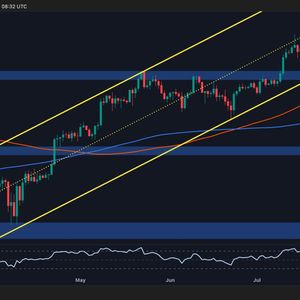BitcoinWorld Crypto Perpetual Futures Liquidation: Unveiling the Shocking 24-Hour Losses The cryptocurrency market, a realm of electrifying volatility and immense potential, often delivers sharp, impactful reminders of its inherent risks. In the last 24 hours, a significant event unfolded in the world of crypto derivatives, leaving a trail of substantial liquidations across major digital assets. If you’re involved in crypto trading, or even just keenly observing the market, understanding these powerful movements, especially the mechanics and implications of crypto perpetual futures liquidation , is absolutely crucial for navigating the market’s often unpredictable currents. What Exactly is Crypto Perpetual Futures Liquidation, and Why Does it Matter? Before diving into the numbers, let’s demystify what we’re talking about. A perpetual futures contract is a type of derivative that allows traders to speculate on the future price of an asset without an expiration date. Unlike traditional futures, perpetuals mimic the spot market price through a mechanism called ‘funding rates’. They are incredibly popular because they offer high leverage, meaning you can control a large position with a relatively small amount of capital (your ‘margin’). This brings us to liquidation . In simple terms, liquidation occurs when a trader’s leveraged position is automatically closed by the exchange due to insufficient margin to cover potential losses. When the market moves against a trader’s leveraged position, and their equity (initial margin plus/minus profit/loss) falls below a certain maintenance margin level, the exchange steps in to prevent the account balance from going negative. This automatic closure is the liquidation, and it means the trader loses their entire margin for that position. Why does it matter so much? For individual traders, it represents significant, often total, loss of capital on that specific trade. For the broader market, large-scale liquidations can create a domino effect, pushing prices down further as exchanges sell off assets, leading to more liquidations – a phenomenon known as a ‘liquidation cascade’. This is why monitoring crypto perpetual futures liquidation data provides critical insights into market sentiment and potential price movements. The Staggering 24-Hour Crypto Perpetual Futures Liquidation Breakdown The recent 24-hour period has been particularly telling, showcasing substantial losses for traders holding leveraged positions. Here’s a detailed look at the numbers: Cryptocurrency Total Liquidation Value Percentage of Long Liquidations Ethereum (ETH) $140 million 78.40% Bitcoin (BTC) $38.31 million 84.98% Solana (SOL) $27.88 million 87.72% These figures paint a vivid picture of market activity. Ethereum (ETH) saw the largest liquidation volume, an astonishing $140 million. This highlights ETH’s significant role in the DeFi ecosystem and its popularity among leveraged traders. Bitcoin (BTC), the market’s behemoth, experienced over $38 million in liquidations, while Solana (SOL), a rapidly growing ecosystem, contributed nearly $28 million to the total. What’s particularly striking across all three assets is the overwhelming percentage of ‘Long’ liquidations. Why Were So Many Long Positions Liquidated? Unpacking Market Dynamics The high percentage of long liquidations (positions betting on price increases) clearly indicates that the market experienced a significant downward price movement. Here’s why this typically happens: Market Correction or Downturn: A sudden or sustained dip in asset prices directly impacts long positions. As prices fall, the value of a long position decreases, pushing the trader’s margin balance closer to the liquidation threshold. Over-Leveraging: Many traders, fueled by optimism or the fear of missing out (FOMO), often take on excessive leverage. While leverage amplifies potential gains, it also drastically magnifies losses, making positions far more susceptible to even minor price fluctuations. Lack of Stop-Loss Orders: Without proper risk management tools like stop-loss orders, traders allow their losses to accumulate, eventually leading to the exchange forcibly closing their positions. Cascading Effects: When a large number of long positions are liquidated, it creates selling pressure on the market. This downward pressure can trigger further liquidations, creating a negative feedback loop that accelerates price declines. Unexpected News or Macro Events: Sometimes, unexpected macroeconomic data, regulatory news, or significant market events can trigger sharp price movements, catching leveraged traders off guard. The dominance of long liquidations in this 24-hour period serves as a powerful reminder of the risks associated with bullish bets in a volatile environment, especially when coupled with high leverage. Navigating the Volatile Seas: Strategies to Mitigate Crypto Perpetual Futures Liquidation Risk Understanding crypto perpetual futures liquidation is one thing; avoiding it is another. While no strategy can guarantee immunity from market volatility, adopting disciplined trading practices can significantly mitigate your risk exposure: Prudent Leverage Management: This is perhaps the most critical advice. Avoid using maximum leverage, especially if you are new to futures trading. Start with low leverage (e.g., 2x-5x) to give your positions more breathing room against price swings. Implementing Stop-Loss Orders: Always set a stop-loss order when entering a leveraged trade. This automatically closes your position if the price reaches a predetermined level, limiting your potential losses and preventing liquidation. Effective Position Sizing: Never allocate a disproportionately large percentage of your total trading capital to a single leveraged trade. Diversify your risk across multiple smaller positions or different asset classes. Continuous Market Analysis: Stay informed about market trends, news, and sentiment. Understanding potential support and resistance levels, as well as upcoming economic or crypto-specific events, can help you make more informed trading decisions. Understanding Margin Requirements: Familiarize yourself with the initial margin and maintenance margin requirements of your chosen exchange. Always keep sufficient collateral in your account to avoid unexpected liquidations. Risk-Reward Ratio: Before entering a trade, calculate your potential risk (maximum loss) versus your potential reward (target profit). Only take trades where the reward significantly outweighs the risk. Remember, the goal isn’t just to make profits, but to preserve capital. Responsible risk management is your best defense against the sudden and often brutal impact of crypto perpetual futures liquidation . Conclusion: Navigating the High-Stakes World of Perpetual Futures The recent 24-hour breakdown of crypto perpetual futures liquidation serves as a stark reminder of the inherent volatility and amplified risks present in leveraged cryptocurrency trading. While perpetual futures offer incredible opportunities for magnified gains, they demand a profound understanding of market dynamics, rigorous risk management, and disciplined execution. The significant long liquidations across ETH, BTC, and SOL underscore the dangers of over-leveraging and the importance of preparing for market downturns. For any trader looking to engage with these powerful instruments, continuous education, a conservative approach to leverage, and the strategic use of risk mitigation tools are not just recommendations—they are essential for survival and long-term success in this exhilarating yet challenging market. Frequently Asked Questions (FAQs) 1. What is a perpetual futures contract in crypto? A perpetual futures contract is a type of derivative in cryptocurrency trading that allows traders to speculate on the price of an asset without an expiry date. Unlike traditional futures, it uses a ‘funding rate’ mechanism to keep its price anchored to the underlying spot market price, offering continuous trading opportunities with leverage. 2. How does crypto liquidation work? Crypto liquidation occurs when a trader’s leveraged position is automatically closed by an exchange because their margin balance falls below the required maintenance margin. This happens when the market moves unfavorably against their position, and they no longer have enough collateral to cover potential losses, resulting in the loss of their initial margin for that trade. 3. Why are long positions liquidated more often during market downturns? Long positions are bets that an asset’s price will increase. During a market downturn, prices fall, directly impacting these positions. As the price drops, the value of a long position decreases, pushing it closer to the liquidation price. Conversely, short positions (bets on price decreases) would be profitable in a downturn. 4. What is ‘leverage’ in crypto futures trading? Leverage in crypto futures trading allows you to open positions larger than your actual capital. For example, with 10x leverage, a $100 margin can control a $1,000 position. While it can magnify profits, it also significantly amplifies losses, making your position more vulnerable to liquidation with smaller price movements. 5. How can I avoid liquidation in crypto futures trading? To avoid liquidation, it’s crucial to manage risk effectively. Key strategies include using lower leverage, setting strict stop-loss orders to limit potential losses, employing proper position sizing (not risking too much capital on one trade), and continuously monitoring market conditions to make informed decisions. 6. Is perpetual futures trading suitable for beginners? Due to its complexity, high leverage, and significant risk of liquidation, perpetual futures trading is generally not recommended for beginners. It requires a strong understanding of market dynamics, risk management, and technical analysis. It’s advisable for new traders to start with spot trading and gradually learn about derivatives before engaging in perpetual futures. If you found this breakdown of crypto perpetual futures liquidation insightful, please share it with your fellow traders and crypto enthusiasts on social media! Your shares help us spread valuable knowledge and foster a more informed trading community. To learn more about the latest crypto market trends, explore our article on key developments shaping Bitcoin price action. This post Crypto Perpetual Futures Liquidation: Unveiling the Shocking 24-Hour Losses first appeared on BitcoinWorld and is written by Editorial Team







![[LIVE] Ten Years of Ethereum: From Smart Contracts to a Global Financial Layer [LIVE] Ten Years of Ethereum: From Smart Contracts to a Global Financial Layer](https://resources.cryptocompare.com/news/52/49239922.jpeg)








